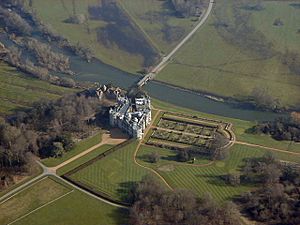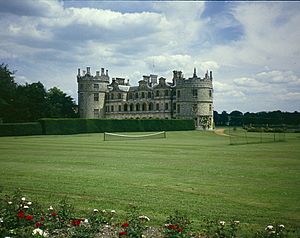Longford Castle facts for kids
Longford Castle is a grand old house located by the River Avon. It stands south of Salisbury in Wiltshire, England. This castle is the home of the Earl of Radnor. It is also a great example of an Elizabethan prodigy house. A "prodigy house" was a very large and fancy country house built by rich people in England during the time of Queen Elizabeth I.
Contents
History
Building a New Castle
In 1573, a man named Thomas Gorges bought the land where Longford Castle now stands. The old house on the property had been damaged by fire. Around 1576, Thomas Gorges married Helena Snakenborg. She was from Sweden and was a Lady-in-waiting to Queen Elizabeth I.
Thomas and Helena decided to rebuild the house. They designed it as a triangular castle, like some castles in Sweden. It was built right on the banks of the River Avon. Building the castle was very expensive. There were problems with the ground, which made the work difficult.
Sir Thomas Gorges was also the governor of Hurst Castle. He knew about a shipwreck from the defeated Spanish Armada. This was a fleet of Spanish ships that tried to invade England. Sir Thomas asked his wife to talk to the Queen. He wanted the Queen to give them the gold and silver from the shipwreck. The Queen agreed! The treasure from the shipwreck helped to pay for the rest of the castle. The building was finished in 1591 under the guidance of John Thorpe. The Gorges family lived in the castle for several years before it was fully completed.
Early Descriptions
In 1603, the royal family visited the area. Roger Wilbraham described Longford Castle as "a fair new house of stone." He noted its triangle shape with three large towers at each corner. These towers held Sir Thomas Gorges' favorite rooms. The castle also had a beautiful garden and green walking paths.
The main building had many floors. It was triangular with a round tower at each corner. These three towers were said to represent the Father, the Son, and the Holy Ghost. Inside, there was a chapel, a kitchen, many sitting rooms, and bedrooms. Fresh cold water was pumped to different floors. There were even toilets that used rainwater! Outside, there was a park, a fruit garden, and a kitchen garden.
New Owners and Changes
In 1717, Longford Castle became the home of the Bouverie family. Sir Edward des Bouverie bought it from the Coleraine family. It is said that Sir Edward saw the castle while riding by and instantly loved it. He supposedly had enough money in his saddlebag to buy it right away!
Later generations of the Bouverie family made the castle's inside and the park around it even more beautiful. By 1773, a formal park with avenues and paths surrounded the castle. They even got advice from a famous landscape designer named Lancelot Brown around 1777.
However, Jacob, the 2nd Earl of Radnor, wanted to change the castle a lot. He hired James Wyatt to turn it into a hexagonal palace. He removed one of the old Elizabethan towers. He replaced it with a bigger one of his own design. He also added two more towers and connected them all. In 1832, the 3rd Earl created a new formal garden. It was designed in the style of the 17th century.
The idea of a hexagonal palace was not fully finished. Jacob, the 4th Earl of Radnor, made the last big changes to the castle. These were done by Anthony Salvin. He added a second courtyard and put a dome over the central courtyard. He also added a square tower and changed the formal garden again.
Present Day
Longford Castle is a Grade I listed building. This means it is a very important historical building. It is located in the parish of Odstock. The formal garden, pleasure grounds, and park are also listed as Grade II on the Register of Historic Parks and Gardens. This means they are also historically important.
Today, the castle is still the home of William Pleydell-Bouverie, the 9th Earl of Radnor. You can visit the castle on special pre-booked tours. It is open to the public for 28 days each year.
Other Notable Uses
Longford Castle has been used or featured in several interesting ways:
- It was the model for the "Castle of Amphialeus" in Sir Philip Sidney's famous book, The Countess of Pembroke's Arcadia (published in 1590).
- During World War I (1914–1918), the castle was used as a hospital.
- During World War II (1939–1945), British and American soldiers stayed at the castle. Important military leaders like Field Marshal Bernard Montgomery and Gen. Mark Clark visited there.
- Longford Castle was shown from the air at the end of the 2001 movie The Princess Diaries. It was shown as the castle in the fictional country of Genovia.




